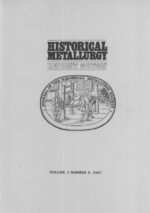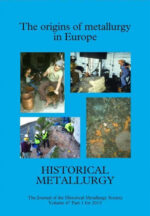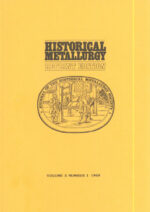Journal Contents
Metallurgical investigation of an iron plate found in 1837 in the Great Pyramid at Gizeh, Egypt
El Sayed E l Gayar and M P Jones
Pages 75-83
An ironplate was found by an excavation team in the Great Pyramid at Gizeh, Egypt in 1837. This plate was said to have been found near an air passage high up on the flank of the Pyramid, but located within an undisturbed portion of that structure.
The plate was not examined in any detail at the time and it has since been in the safe keeping of the British Museum in London. A small fragment of the plate has now been subjected to detailed examination by modern metallographic techniques.
These techniques have shown, conclusively, that the plate consists of numerous laminates of wrought iron and that these laminates have been inexpertly welded together by hammering. The various layers differ from each other in their grain sizes, carbon contents, the nature of their non-metallic inclusions, and in their thicknesses. Some of the non-metaUic inclusions are thought to consist of un-reacted (or incompletely reacted) fragments of the iron ore that was used to produce the iron metal. Other “inclusions” consist of iron oxide “scale” between the inexpertly welded iron laminates, and the sodium-and potassium-rich “ashy” remnants of the charcoal fuel that had been used during the smelting operation.
Analytical study of composite shot from the Mary Rose
Robert Walker, Richard Dunham, Alexzandra Hildred and Margaret Rule
Pages 84-90
The Tudor warship Mary Rose sank on 19 July 1545 in the Solent during an action between a fleet of English ships commanded by Lord Lisle and a major task force commanded by the French Admiral, Monsieur d’Annebault.
Immediate attempts were made to salvage the Mary Rose, resting on her starboard side at a depth of between ten and twelve metres. By early August her foremast was broken and the task was abandoned by the end of August. Over the next four years the salvaging of individual items continued, and payments are noted for recovering brass guns.
Gradually the site stabilized. The weight of the laden ship had caused her hull to penetrate the upper sediments when she sank, and the keel settled on hard clay beneath. Silt was carried in suspension through the open hatches and gunports and settled within the still water inside the hull.
An unusual wrought iron artefact: the Pearsall Gate
Malcolm Tucker
Pages 90-91
During the Autumn 1987 HMS Council Meeting an application for a grant to help conserve an early 19th century wrought iron artefact was made on behalf of the Avon Wildlife Trust, a Bristol based organisation. This was favourably received and together with money from the Science Museum Fund for the Preservation of Technological Material, made it possible to commission remedial work through the Area Museums for the South West. This has now been completed, the ‘Pearsall gate’ is displayed, suitably annotated at Willsbridge Mill and the person responsible for the discovery of this object, Malcolm Tucker, a chartered structural engineer with a particular interest in the history of such items has agreed to write a short resume of its importance
Dr Percy and his metallurgical collection
Sue Cackett
Pages 92-98
John Percy died on 19 June 1889, so it seemed fitting in 1989 to attempt to piece together a short biography and to give at least an insight into the metallurgical collection which bears his name.
Unfortunately there is not much evidence to draw upon to produce more than an outline of his life. Much of the information comes from the numerous obituary notices published in a wide range of Journals, but inevitably they all seem to have cribbed from one another and do not tell the whole story.
Metallurgical analysis of iron artefacts from Thailand
L M Hogan and S Rutnin
Pages 99-107
Four iron artifacts excavated in Northeast Thailand have been subjected to metallographic examination. Three of the artifacts, dated to the Late Iron Age (eg 300-400 AD) exhibit competent forging and welding of wrought iron, with cutting edges hardened by cementation. The fourth artifact was undated but exhibits a difficult blacksmithing technique, involving welding an ultra-high carbon content steel onto a wrought iron core to form a high quality axe blade. Details of heat treatments are reconstructed and invoke the suggestion that the undated axe-head may be contemporary with the other artifacts.
Water power and cylinder blowing in early South Wales coke ironworks
Laurence Ince
Pages 108-111
It has recently been demonstrated by J E Rehder how changes in iron smelting took place when charcoal was replaced by coke as the fuel. These changes included a decreased production rate and the need for a greater supply of blast air. Sulphur which was present in coke produced an iron which was unsuitable for refining into wrought iron. The sulphur problem was not a great worry for Abraham Darby as he desired to make iron solely for the casting trade. Various techniques for increasing the blast air were attempted at Coalbrookdale and by the mid 1740s iron production from a single furnace was running at about 17 tons per week.
It could well be that at this stage it was discovered the effect that an increase of limestone in the charge had on the higher temperature coke iron.’ A higher melting point slag on the basic side was able to do some desulphurisation. This and using low sulphur coals (clod) probably produced coke iron which could be fined into wrought iron. This was the discovery made by Abraham Darby I I at the Coalbrookdale furnaces.
The Historical Metallurgy Society in retrospect
Richard Doncaster
Pages 112-113
In 1989 Historical Metallurgy had its 25th Annual General Meeting and its 25th Conference. But the Society is older than 25 years of age and perhaps members would like to know how it all came about.
Two Brazilian iron works of the early 19th century Part 2, Metal and slag analyses
D Horstmann and F Toussaint
Pages 114-119
It is now possible to send you the results of our examination of the slag and iron samples mentioned in the last paragraph of the article in your Journal, Volume 22 No. 2 1988.
This material has been kindly provided by Dr Toenges, technical director of the Furteco mines, which own the “stiickofen”, these have very odd shapes. The reason is that they have a cellular skeleton of metallic iron as shown in Fig 2. The iron forming the skeleton consists of small particles sintered together and mixed up with particles of slag, as shown in Figs 3 & 4.1n some places the originally pure iron (reduced in the solid state) is already slightly carburised, which is shown by the Eschwege plant at Congonhas. The slag investigation has been carried out at the Max Planck Institute for iron research in Dusseldorf, while the iron samples were examined at the laboratory of Edelstahlwerk, Lindeburg, Remscheid.
Tin smelting at Week Ford, Dartmoor; a brief note
Bryan Earl
Page 119
The initial report on Bryan Earl’s investigation of the two Week Ford blowing houses at SX 662724 and associated material at the site shows that smelting operations were well established by 700 A D . Stereo colour air photographs and surface investigation show a long-term series of developments from the ‘hut circle’ noted on Ordnance Survey maps, through tin dressing, then dressing and smelting which were abandoned by about the eighteenth century, to the present day remains.
Early coke ovens: a note
David Cranstone
Pages 120-
Very little archaeological work appears to have been done on the development of the coke oven. Published examples date almost entirely from the mid-19th century or later, when large banks of ovens associated with the railways became common. These ovens are almost invariably of the ‘standard’ beehive form, with a large apical opening for top-loading (often from tubs running on rails), and a front unloading opening, normally with a ‘coke bench’ outside. Consideration of the earlier development of the coke oven has relied almost entirely on Jars’ description and illustration of an oven in Newcastle in 1765; while this is a valuable example, it should not be assumed to give a complete picture of the 18th century development of the coke oven. A chronological survey of the known pre-railway examples (from modem field recording and from contemporary documentary evidence) therefore seems worthwhile.






There are no reviews yet.